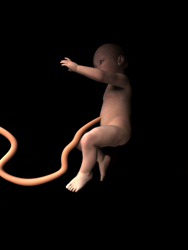Placenta transfers pesticides to foetus
Xenobiotics are chemicals that are found in organisms but their source is external as they are not produced there. One common group of xenobiotic is the organochlorines. In industry, they have a very broad range of uses including solvents and insecticides. If biologically active, they can be toxic. One notable example is dichloro-diphenyl-trichloroethane (DDT). As an insecticide, it was proved to be responsible for population reduction of animals like birds of prey due to egg-shell thinning. The EC-funded project PLUTOCRACY has accumulated data on a more insidious effect of xenobiotics - that is, the predisposition to allergic diseases. The research centred on the premise that exposure to xenobiotics during pregnancy may cause intrauterine sensitisation. This may then result in the development of the allergy on further exposure to the allergen after birth. The project team at the University of Bristol studied the first steps of the process in the exposure of the foetus, transfer across the placenta and then accumulation in tissues. To do this, they used an ex vivo placenta model that was perfused (bathed in fluid with necessary nutrients). They measured the radioactively traceable xenobiotics in the maternal and foetal circulation as well as chemical accumulation in the placental tissue and foetal organs. The organochlorines studied included DDT and dichlorobenzene (DCB), another insecticide. Polychlorinated biphenyls (PCBs), used in floor finishes and adhesives, were also monitored. The scientists found that all the xenobiotics crossed the placenta to the foetus by the process of passive diffusion although DCB diffused more rapidly. In key foetal organs the concentration of some of the pesticides was higher than that of equivalent maternal tissues. These included blood, spleen, bone marrow, brain and liver. The implications of this research are far-reaching as organochlorine accumulation in foetal tissue could impact on the development of nervous and immune systems. This could then result in postnatal health problems. Further data combined with that accumulated from this research can be used in a multidisciplinary approach. This could include mathematical and pharmokinetic modelling.







